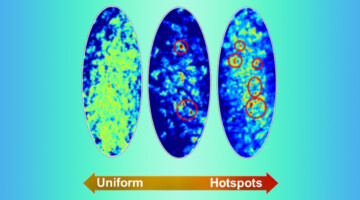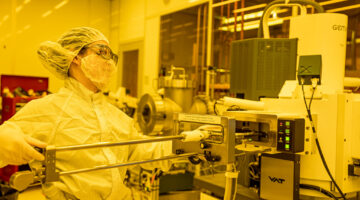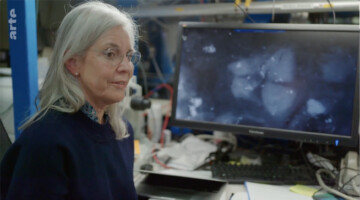Superhelical symmetry can be found in helical repeat proteins, and de novo helical repeat proteins are rigid and amenable to stacking in a head-to-tail fashion, which is an important factor in building up coincident symmetries. Now, using cyclic helical repeat proteins, Baker and colleagues generate protein nanostructures—as depicted on the cover—with coincident cyclic and superhelical symmetry axes. Read more »
Will Chueh to Receive the 2023 Shirley Award
Will Chueh of Stanford University is the 2023 winner of the Shirley award for Outstanding Scientific Achievement at the ALS. His selection recognizes Chueh’s deep contributions in operando soft x-ray spectromicroscopy for imaging electrochemical redox phenomena—images and movies for battery and electrocatalytic reactions. Read more »
ALS in the News (August 2023)
-
-
-
-
- Junko Yano appointed director of Berkeley Lab’s Molecular Biophysics and Integrated Bioimaging Division
- R&D 100 awards honor Berkeley Lab innovations
- How scientists are accelerating next-gen microelectronics
- Berkeley Lab researchers receive DOE early career research awards
- FY24 budget outlook: DOE Office of Science
- Making renewable, infinitely recyclable plastics using bacteria
- Smith breaks new ground with domain wall research
- Berkeley Lab Director Mike Witherell on modernizing the Lab in support of tomorrow’s world-class science
-
-
-
Fluctuations Mark Phase Changes in Magnetic Films
Researchers discovered that nanoscale spin fluctuations deep inside ordered states of a magnetic film can characterize phase transitions, independent of underlying magnetic interactions. The results provide a new way to predict and understand phase transitions in materials relevant to high-density, energy-efficient microelectronics. Read more »![]()
![]()
Eco-Friendly Processing of Organic Photovoltaics
Researchers controlled the mixing of electron-donating and -accepting constituents of an organic photovoltaic (OPV) material made using a process that replaces toxic solvents with water. With efficiencies comparable to less eco-friendly OPVs, this material shows promise for many advanced device and building applications. Read more »![]()
![]()
How Scientists Are Accelerating Next-Gen Microelectronics
A new center, called CHiPPS—or the Center for High Precision Patterning Science—led by Berkeley Lab microelectronics expert Ricardo Ruiz, could accelerate the next revolution in microchips, the tiny silicon components used in everything from smartphones to smart speakers, life-saving medical devices, and electric cars. Read more »
An Organic Transistor That Can Sense, Process, and Remember
Traditional AI hardware employs physically separated information sensing, processing, and memory architecture, a configuration that suffers from large energy and time overhead. Now, researchers have fabricated an organic transistor device that can simultaneously act as the sensor and processing core of a streamlined AI hardware system. Read more »
Controlling the Structure and Morphology of Organic Nanofilaments Using External Stimuli
Coexisting organic helical and helicoidal crystalline nanofilaments formed by molecules with a bent molecular shape can now be transformed to a smectic liquid crystal phase or only helical nanofilaments by applying an electric field or irradiating the sample with UV light. Read more »
Organic Matrix Derived from Host–Microbe Interplay Contributes to Pathological Renal Biomineralization
A composite image of a rare form of kidney stone, illustrating extensive organic filamentous networks abundant with immune response-related proteins such as calprotectin (displayed in red), myeloperoxidase (in yellow), and DNA molecules (in blue). Originating from intricate host-microbe interplay, these organic networks promote the heterogeneous nucleation and precipitation of inorganic particulates. Read more »
ALS Work on Roman Concrete Highlighted in German-French Documentary
A study on the remarkable durability of 2000-year old Roman concrete, by ALS user Marie Jackson with ALS beamline scientist Nobumichi Tamura, was recently highlighted in “Miracle Materials,” a science documentary produced by a German-French company, Gruppe 5, for airing on the Eurpean public service channel, ARTE. Read more »
- « Previous Page
- 1
- …
- 11
- 12
- 13
- 14
- 15
- …
- 83
- Next Page »








